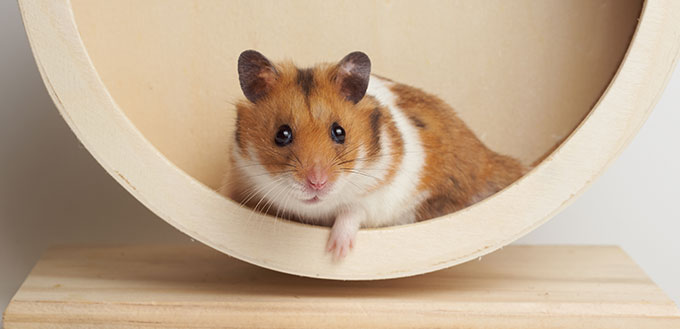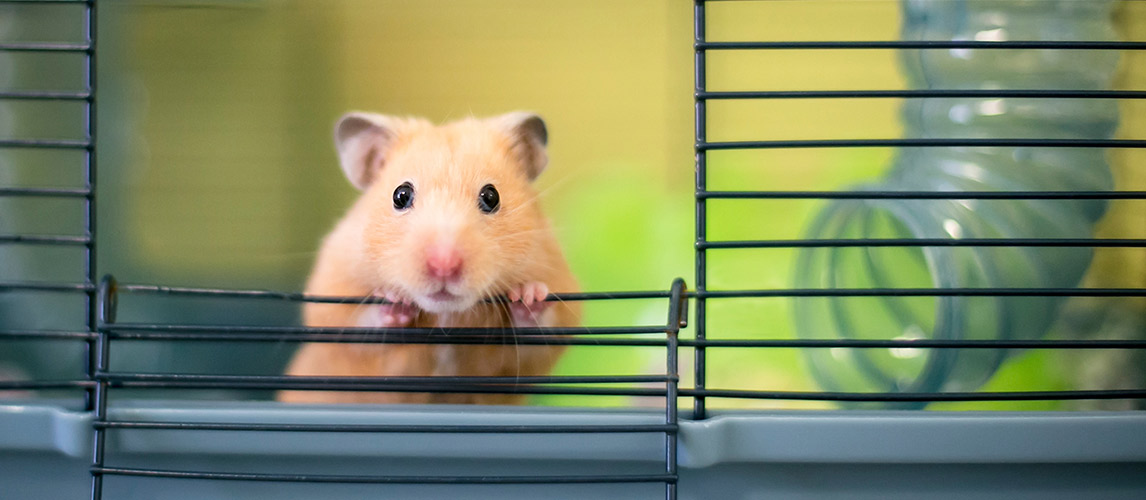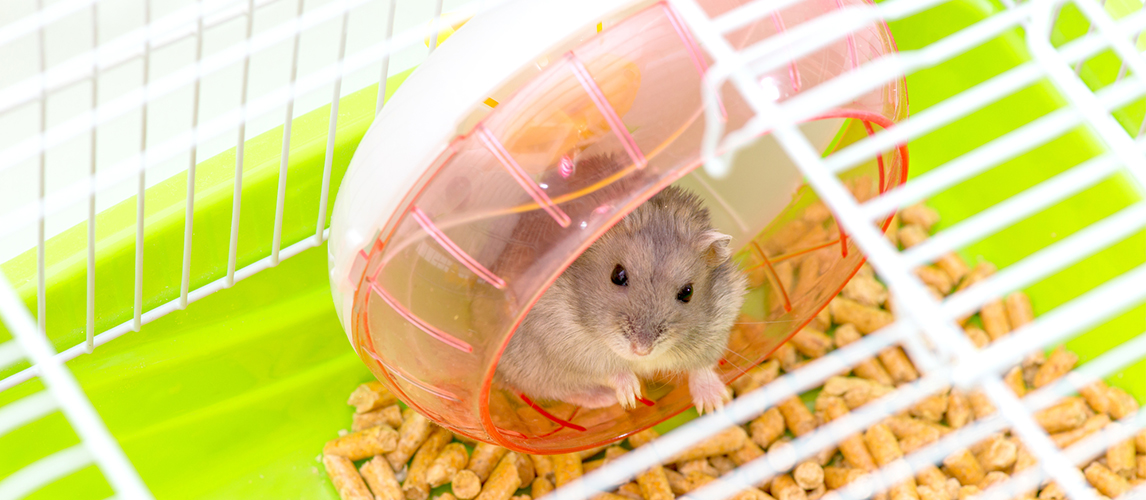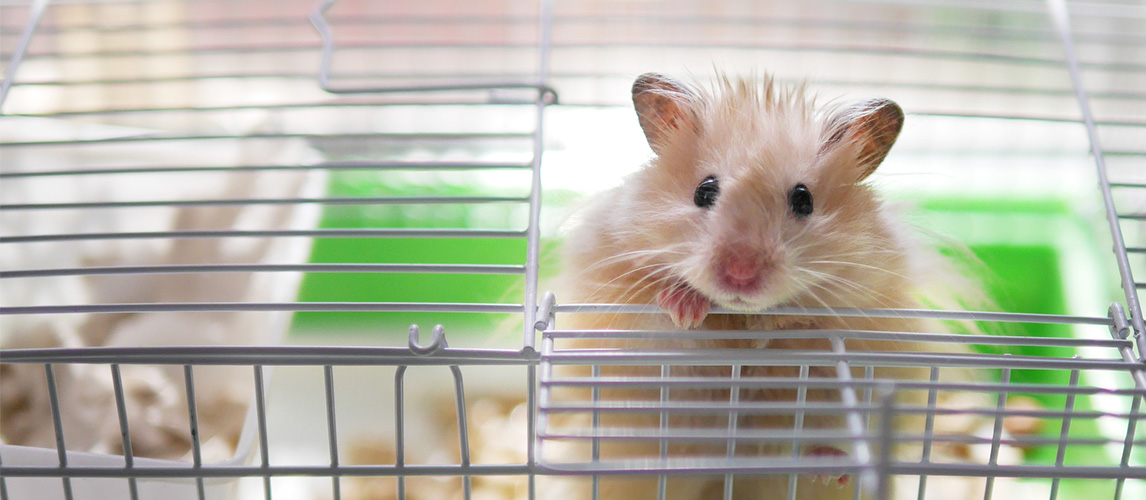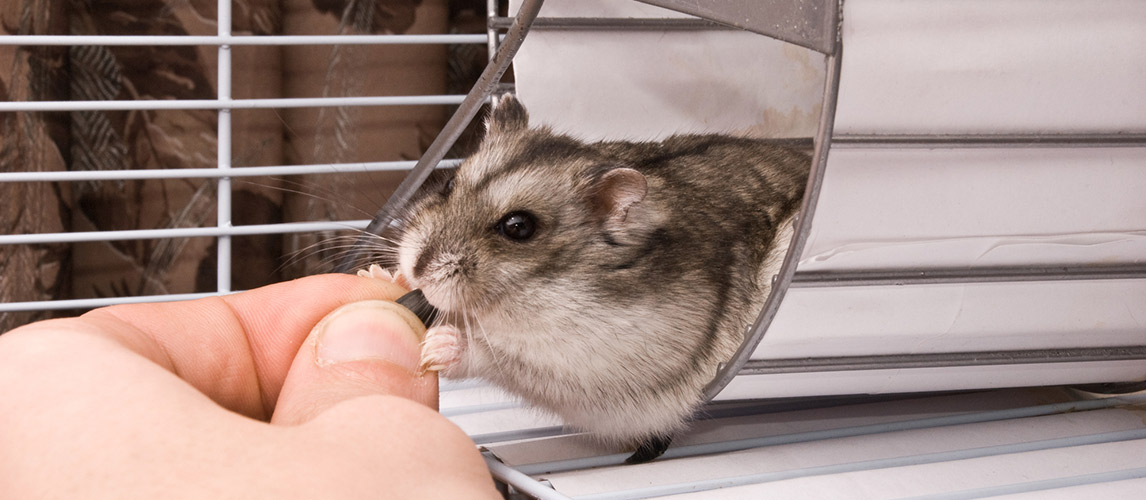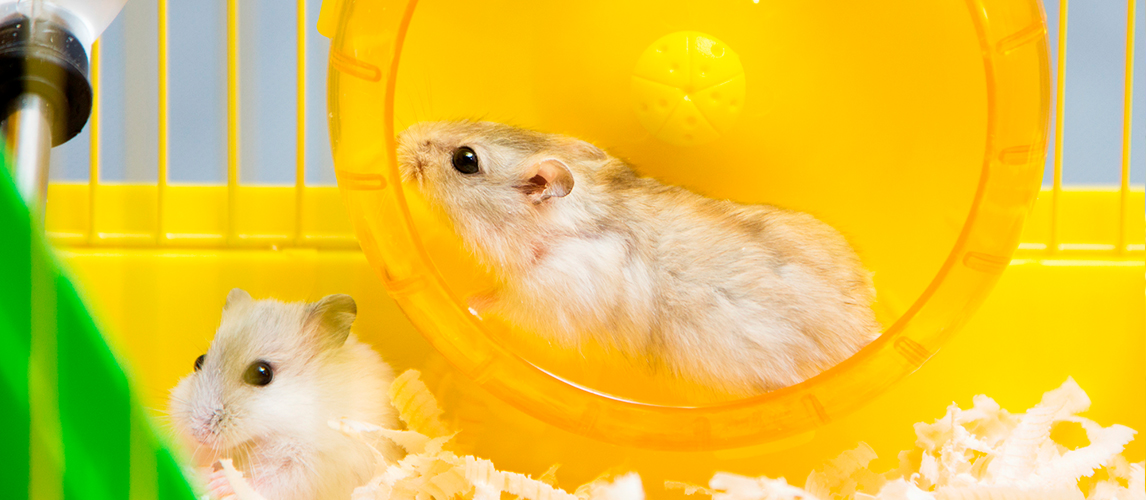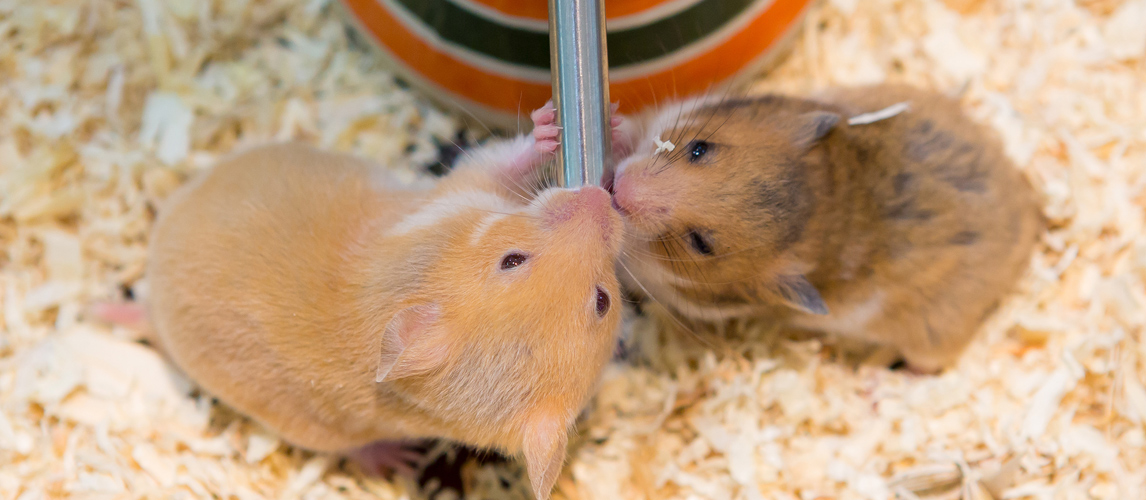Syrian hamsters are a popular and relatively hassle-free pet. They do not make great demands on your time but that does not mean that you can ignore them! You need to provide them with plenty of room to exercise and appropriate food as well as fresh water and you must clean them out regularly. If they are handled daily from a young age, they will enjoy interacting with their human family and can be adorable little companions. In this article, we take you through some basic information that you need to know about owning a Syrian hamster.
Species Overview
| Scientific Name: | Adult Size: | Adult Weight: | Life Expectancy: |
|---|---|---|---|
| Mesocricetus auratus | Five to nine inches | Around five ounces | Between two and four years |
Short History of the Syrian Hamsters
You may be surprised to know that there are at least 18 species of wild hamster and that the Syrian hamster is actually one of the rarest! For years it was considered to be a rodent with a natural habitat near the city of Aleppo in Syria. The earliest cataloged records date back to 1797 but it would have lived for many thousands of years before this.
Its history as a pet hamster starts off in 1930 when a biologist called Israel Aharoni set up an expedition to track the hamsters. His interest had been triggered by reports of an animal that was called a golden hamster and had been given an Arabic name that meant “Mr. Saddlebags” after its impressive cheek pouches! The aim was to find a hamster that would breed in captivity and therefore be suitable for medical research. With the help of a local hunter, Aharoni was successful and captured one litter. It is thought that all Syrian hamsters kept as a pet today descended from that one litter which may explain why inherited heart problems can be an issue.
Syrian Hamster Appearance
How Big do Syrian Hamsters Get?
As adults, Syrian hamsters are about the size of your hand. They are larger than the Roborovski dwarf hamsters and this makes them easier to handle and a little more robust. An adult Syrian hamster will weigh between five and seven inches long and weigh around four or five ounces.
What do Syrian Hamsters Look Like?
Syrian hamsters have a body that is rounded and stocky and they have stumpy tails that are not easy to see! Their facial characteristics are large eyes and tulip-shaped ears are which are small, neat, and covered in fur. These hamsters have stocky little legs and wide feet.
In terms of hair length, there is a short-haired type and a long-haired Syrian hamster (some people call these Teddy Bear hamsters or Angora hamsters). The original Syrian hamster was a golden color and this is why they are also sometimes called the Golden hamster. These days, they are a range of colors including black, white, golden, and brown and some are a combination of colors.
Fun Facts
Here are five fun facts that you may not know about Syrian hamsters!
- Hamsters have teeth that grow continuously so they need lots of things to gnaw on.
- Your hamster likes a lot of exercise and most of that takes place at night.
- Hamsters like to burrow and sleep in enclosed spaces.
- Your hamster needs to be kept alone from the age of 6 weeks.
- Hamsters have pouches that reach from their jaw to their shoulders!
Golden Hamster Temperament
Syrian hamsters are very popular in the pet trade and widely available in pet stores as well as from private breeders. This is mainly due to their easy-going nature and cute appearance. Here are the main things that you need to know about their behavior and temperament
Syrian Hamsters as Pets
These hamsters make great pets for families with children. They tolerate humans handling them very well and as long as you take care to hold them gently and carefully they do not seem to mind the experience. You cannot expect them to form a strong bond with one person or with lots of family members in the same way as a cat or dog would. However, they will stretch up the bars of the cage to say hello to you and take some tasty treats from your hand.
The key to Syrian hamster care and to getting them accustomed to handling is to hold them often, especially when they are young. There are plenty of information articles giving guidance and tips on how to hold a hamster. One of the most popular approaches is to rub your hands in the bedding so that you smell like they do and leave your hands close to the hamster at first without attempting to pick them up. After doing this a couple of times, you can move on to scooping them up rather than grabbing them from above. This can spook some hamsters.
These hamsters have sharp teeth and can give a nasty bite but with regular and appropriate handling this is not very likely to happen. Never try to pick up a sleeping hamster, they will assume that you are attacking them and that is likely to result in a nasty nip.
Living Arrangements
Syrian hamsters like to have a living environment to themselves. They are solitary animals and do not like to live in groups or pairs (apart from when mating). If you try to get these hamsters to live in pairs or groups they will fight with each other and even kill each other. Most people only care for one Syrian hamster but if you want another you will need two cages. Obviously, the female will need to be with her young until they are weaned. They are not too keen on other pets either so the best approach is to keep your pet secured in their cage and only handle them when there are no other pets around.
They prefer to sleep all day and become very active at night which can cause a problem if you have chosen to store the cage in a bedroom. Despite the fact that your pet is very small, they can make a lot of noise that will keep you awake. They like to run around the cage, climb up the bars of the enclosure and have a go on their exercise wheel which produces a series of bangs and squeaks! You may find that the best option is to keep the cage in a room where no one is sleeping.
Sometimes hamsters will adapt their sleeping schedule to suit their human family and will be awake in the morning or evening so that you can interact with them.
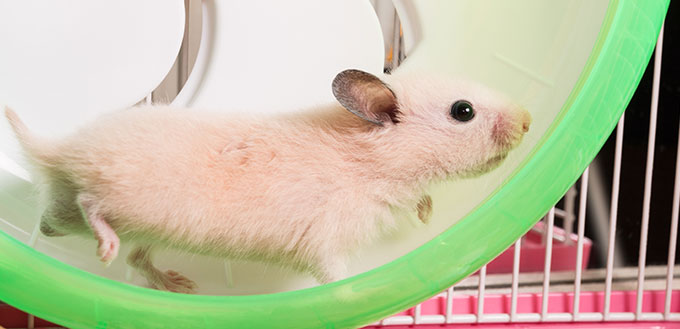
Health & Care
You can expect your Syrian hamster care duties to take up a few hours a week. You will need to feed them, provide fresh water and check that they are okay every day. Their cage will need to be cleaned out every few days to remove the bedding that has been soiled with urine or feces.
Handling
One of the main times that you will need to handle your hamster is when you are cleaning out their cage. You need to lift them gently out and place them in a secure box or small carrier that you can get from pet shops. Remove all of the articles such as toys and food bowls so that you can get at the interior surface of the enclosure. It is important to remove all of the stale food. However, you can retain a small part of the bedding and put it back in with the fresh bedding so that your hamster feels that it smells familiar.
You must use only water to clean them out as cleaning products contain chemicals that can be harmful to hamsters. Alternatively, you can ask at your local pet store about a cleaner specially designed for hamster cages. Use a damp cloth to wipe down every article from the cage and check it for damage. Then, put in some fresh bedding and pop your hamster back in.
Feeding
The hamster diet is not complicated. There is no fixed feeding time, you just need to refresh the food once a day and they will graze on it. The best option for these pets is to use a special hamster mix that contains nuts, grains, and seeds. There are many types of hamster food available and most of them provide all the nutrients that hamsters need in their diets. For more information on hamster food, check out our review article.
However, watch out for selective feeding. If you use a food that has different colored or shaped morsels in it, your hamster may avoid one kind and favor another. This can lead to them not getting a balanced diet. As well as their basic diet, you should add in some food treats to provide enrichment and variety. There is plenty of fruit and vegetables that hamsters love but some fruit and vegetables are not suitable and can even be toxic so always check. It’s best to feed these special snacks in the evening and not offer them every day as too much can result in a stomach upset. Remove uneaten fresh food after 24 hours. Here is a list of some food snacks that are suitable for the hamster diet:
- apples
- broccoli
- carrots
- cauliflower
- pears
- cucumber
Very occasionally you can offer small pieces of cheese or boiled egg as hamsters are omnivores.
Hamsters have a clever way of storing food to eat later. They can store food in their pouches that are located by their cheeks. You will often find piles of stashed food in the cage and these need to be cleaned out every day.
Housing
When it comes to the living environment hamsters need an enclosure or cage-like those reviewed here with as much floor space as possible. You need a lot of floor space for the food bowl, hamster toys, hamster bedding, and plenty of space to run around. The pet shop where you get your hamster will be able to give you plenty of information on the cage size and accessories. Ideally, there will be multiple levels and a hiding place in the enclosure where your hamster can hide away and get some peace.
The cage needs to be made out of strong materials and needs to have metal wires because hamsters are very determined chewers! At the bottom of the cage, you need to provide a substrate that will soak up urine and a soft material that they can create a nest in. You could use wood shavings as the substrate and you could use paper as the bedding but there are plenty more suggestions here. Try to get an enclosure that is deep enough for them to burrow in.
These little pets need something to pass the time so provide some hamster toys that they can climb on or chew (or both) and don’t forget that hamster wheels are firm favorites. There is plenty more inspiration in our hamster toy review.
Water bottles are the best option for providing hydration as they cannot get knocked over and make the bedding wet!
Toilet
Hamsters produce very small and dry poops and a small amount of pee. They will often pick one part of their cage to use as a toilet but you do not have to provide a special litter tray.
If your hamster’s poops become very soft it can be an indication that something is wrong. It may mean that you are feeding too much fresh fruit.
Common Health Problems
A common question is how long do hamsters live -and the answer to this is that it varies with many factors. The following are likely to help your hamster live longer but all hamsters are different and this will always be the case.
- Quality of care: The care that you take to look after your hamster can have an impact on their life expectancy so the actions that you take are important. Buying a suitable wheel can increase exercise and cut down on injuries and providing the correct food can help with overall health.
- Genetics: Some hamsters are bred with close relatives and this cuts down on genetic diversity and makes genetic defects more likely. They can affect any part of the body but heart defects are common in hamsters.
- Illness: Some hamsters are just unlucky and pick up infections and illnesses that shorten their life expectancy.
- Environment: Hamsters are sensitive to their environment in terms of space, temperature, noxious fumes, noise, and so on.
On the whole, hamsters are quite hardy pets but there are some common health issues that you should look out for.
Wet Tail
This is caused by a stomach upset and is often triggered by stress but feeding too much fresh food can also cause problems. You will notice wetness around the tail area as well as lethargy, a lack of appetite, and soft and runny poops. Don’t waste any time, get your hamster to a vet right away.
Skin Problems
Hamsters can suffer from skin mites. These are tiny parasites that cause itching and hair loss. They can be treated so book an appointment with your vet.
Tumors
Sadly, tumors are quite common in hamsters and they can occur anywhere on the body including the adrenal glands and scent glands. Always report any changes to your vet for investigation.
Price
You have the option of getting a Syrian hamster from a pet store, shop, breeder, or rescue center. However, always do your research. In general, a good breeder or a rescue group will have provided higher standards of care. Choose a hamster from someone who is prepared to give you ongoing advice and information and take time talking to you. Look at all the hamsters to make sure that they appear healthy and well cared for. In general, you can expect to pay around $20.
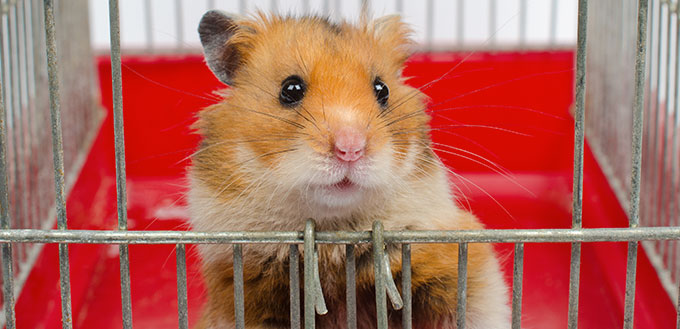
FAQs:
Q: Are Syrian hamsters good pets?
A: If you are prepared to dedicate some time to handling and looking after them, Syrian hamsters make great pets. They are more robust than dwarf hamsters, they move quite slowly and don’t mind being handled. You can have them in most rented accommodation as they are kept in a cage. These hamsters require relatively little equipment and are entertaining and engaging little characters to have in your home.
Q: Are Syrian hamsters cuddly?
A: Syrian hamsters are furry animals but there are many more pets that prefer to be cuddled. You can handle your hamster but they will prefer to run around and will not like to be squeezed. You need to be careful that very young children do not hold them too tightly.
Q: Do Syrian hamsters bite?
A: All animals with teeth have the potential to bite but it does not have to be the case that they bite often. Provided you get your hamster accustomed to handling and only try to hold them when they are wide awake (never when they are asleep), they are unlikely to nip you.
Q: Can a Syrian hamster live alone?
A: Yes! They must be housed alone because they are very territorial and hate the company. They will fight to the death in some cases. If you want to keep a pair of hamsters, you would be better off getting some Roborovski dwarf hamsters.
Note: The advice provided in this post is intended for informational purposes and does not constitute medical advice regarding pets. For an accurate diagnosis of your pet's condition, please make an appointment with your vet.


